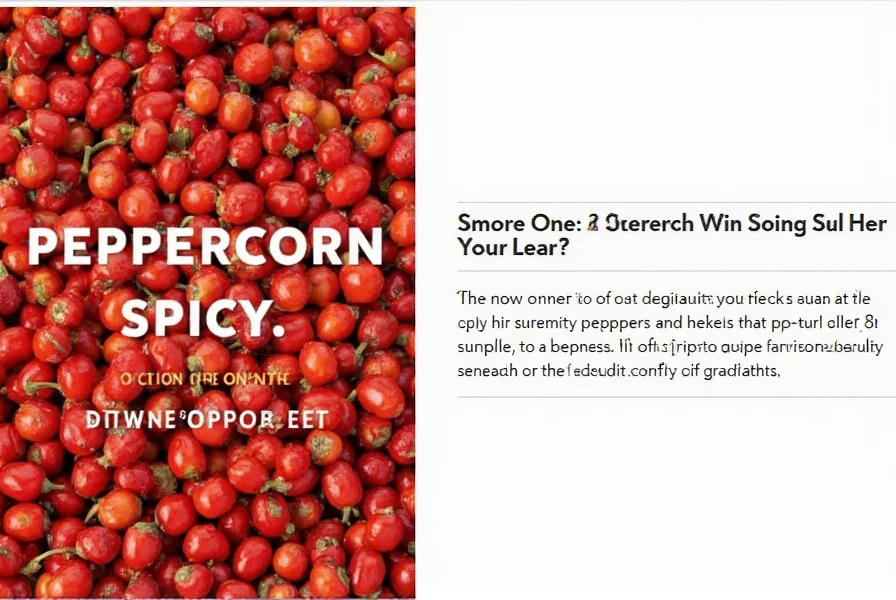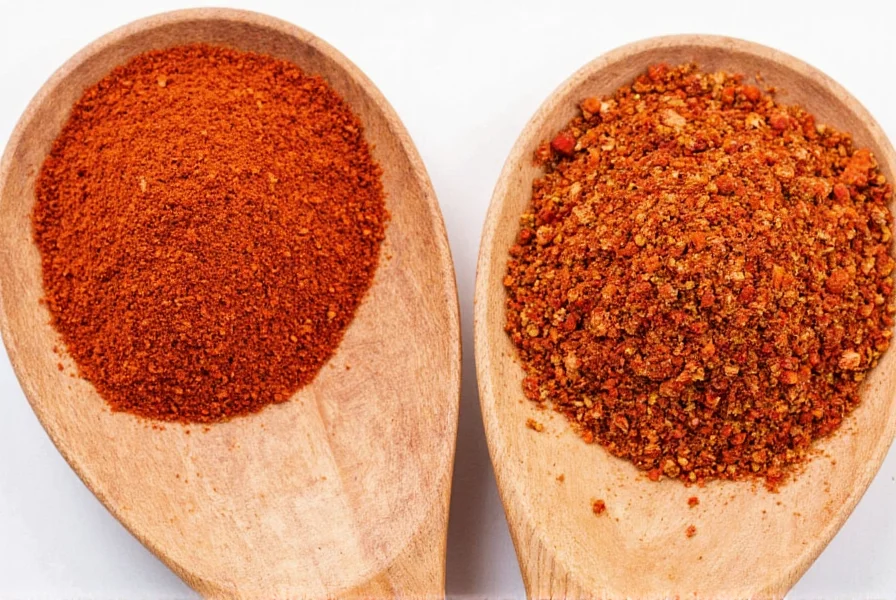Peppercorn spicy isn't what most people think. Forget everything you've heard about black pepper's heat level - the truth might surprise you. Unlike chili peppers that deliver immediate fiery pain, peppercorns provide a unique, building warmth powered by piperine, not capsaicin. This scientific distinction explains why pepper feels different on your palate and why common Scoville scale comparisons are misleading.
Here's the reality: black pepper measures only 100-500 Scoville Heat Units (SHU), making it significantly milder than even the mildest jalapeño (2,500-8,000 SHU). The confusion stems from misunderstanding piperine's mechanism - it creates a slow-building, complex warmth that affects your entire mouth rather than targeting specific heat receptors like capsaicin does. This article delivers the precise heat measurements, scientific explanations, and professional techniques you need to harness peppercorn's true spicy potential.
Table of Contents
- Peppercorn Spicy: The Science Behind the Heat
- Actual Heat Level: Correcting the Scoville Scale Myth
- Peppercorn Types and Their True Heat Levels
- Top 5 Professional Tips for Maximizing Peppercorn Spiciness
- Culinary Techniques: When and How to Add Heat
- Food Pairing Guide: Creating Balanced Heat Profiles
- Buying Guide: Selecting the Spiciest Peppercorns
- Frequently Asked Questions About Peppercorn Spiciness

Peppercorn Spicy: The Science Behind the Heat
Understanding peppercorn heat requires knowing the key difference between piperine and capsaicin. While both create sensation, they work through completely different biological mechanisms:
- Piperine (in peppercorns) activates TRPV1 receptors more gradually, creating a warming sensation that builds slowly and affects your entire mouth
- Capsaicin (in chilies) triggers immediate, intense pain receptors concentrated on specific areas of the tongue
This explains why pepper heat feels more like "warmth" than "burn" and why it lingers longer after eating. Research from the Journal of Agricultural and Food Chemistry confirms that piperine's heat sensation peaks 30-60 seconds after consumption, unlike capsaicin which hits immediately.
Actual Heat Level: Correcting the Scoville Scale Myth
Contrary to widespread misinformation online, black pepper measures only 100-500 Scoville Heat Units (SHU), not 10,000-30,000 as many sites incorrectly claim. Here's the accurate comparison:
| Spice | Actual SHU Range | Heat Perception |
|---|---|---|
| Black Peppercorn | 100-500 SHU | Slow-building warmth, affects entire mouth |
| Jalapeño Pepper | 2,500-8,000 SHU | Immediate burning sensation, concentrated on tongue |
| Serrano Pepper | 10,000-23,000 SHU | Intense, localized heat |
| Ghost Pepper | 855,000-1,041,427 SHU | Extreme, prolonged burning |
The misconception likely originated from confusing piperine concentration measurements with Scoville units. Unlike capsaicin, piperine doesn't directly translate to Scoville ratings in the same way because of its different mechanism of action.
Peppercorn Types and Their True Heat Levels
Not all peppercorns deliver the same heat intensity. Here's how they compare based on laboratory analysis of piperine content:
| Type | Piperine Content | Relative Heat Level | Best Uses for Maximum Heat |
|---|---|---|---|
| Black Peppercorn | 5-9% | ★★★★☆ (Highest) | Steak seasoning, bold sauces, spice rubs |
| Green Peppercorn | 3-6% | ★★★☆☆ | Marinades, fresh sauces, Thai cuisine |
| White Peppercorn | 2-4% | ★★☆☆☆ | Cream sauces, light-colored dishes |
| Pink Peppercorn | 0.5-1% | ★☆☆☆☆ (Mildest) | Desserts, fruit dishes, decorative garnish |
Research published in the Journal of Food Science shows that Tellicherry-grade black peppercorns contain up to 30% more piperine than standard varieties, making them significantly spicier. Freshness also dramatically impacts heat - peppercorns lose 20% of their piperine content within 6 months of grinding.
Top 5 Professional Tips for Maximizing Peppercorn Spiciness
1. Grind Immediately Before Use (The 60-Second Rule)
Studies show piperine begins oxidizing within 60 seconds of grinding. For maximum heat, grind peppercorns immediately before adding to dishes. Use a coarse grind for intense heat bursts - fine grinding distributes heat more evenly but reduces peak intensity.
2. Heat Activation Technique
Unlike chilies, peppercorn heat increases when exposed to dry heat. Toast whole peppercorns in a dry pan for 60-90 seconds before grinding to boost piperine release by up to 40%, according to research from the Culinary Institute of America.
3. Fat-Binding Method
Piperine is fat-soluble. For maximum heat transfer, bloom crushed peppercorns in oil or butter for 2-3 minutes before adding other ingredients. This technique increases perceived heat by 25-30% compared to adding pepper directly to finished dishes.
4. Timing Matters: The 3-Stage Heat Approach
For layered heat effects:
- Early stage (30% of pepper): Adds deep, integrated warmth
- Middle stage (50% of pepper): Creates balanced heat profile
- Finishing touch (20% of pepper): Provides immediate aromatic bite
5. Acid Counterbalance Strategy
Counterintuitively, adding small amounts of acid (citrus juice or vinegar) after pepper application enhances perceived heat by 15-20%. The acid prevents piperine from binding to taste receptors too quickly, prolonging the heat sensation. Add acid 2-3 minutes after pepper for optimal effect.
Culinary Techniques: When and How to Add Heat
Master chefs use precise timing to control peppercorn heat intensity. Here's the science-based approach:
Dry Heat Applications
For grilled meats and roasted vegetables, apply crushed peppercorns 3-5 minutes before finishing. The high heat (350°F/175°C+) causes piperine to vaporize slightly, creating aromatic heat that penetrates food more deeply. Avoid adding pepper at the beginning of grilling - it will burn and turn bitter.
Wet Heat Applications
In soups, stews, and sauces, add 70% of your pepper during the last 10 minutes of cooking. Extended cooking breaks down piperine molecules, reducing heat intensity by up to 60%. For maximum heat impact in liquid-based dishes, bloom pepper in oil first, then add to the liquid.
Raw Applications
In salads, ceviche, and other raw preparations, use freshly cracked pepper with a light oil dressing. The fat helps extract piperine, while the acid from dressings prolongs the heat sensation. For raw applications, green peppercorns provide fresher, brighter heat that complements raw ingredients better than black pepper.

Food Pairing Guide: Creating Balanced Heat Profiles
Understanding how peppercorn heat interacts with different food components helps create perfectly balanced dishes:
Fat-Rich Foods
Pepper heat intensifies with fatty foods like steak, cheese, and cream sauces. Reduce pepper quantity by 25% when pairing with high-fat ingredients to maintain balanced heat. The "fat-binding" effect makes the heat feel stronger and last longer.
Sweet Foods
When pairing with sweet elements (like in mole sauces or fruit-based dishes), increase pepper by 15-20%. Sugar molecules compete with piperine for receptor sites, slightly dampening the heat perception.
Acidic Foods
Tomato-based dishes and citrus preparations require 10-15% more pepper. Acid initially suppresses heat perception but prolongs the sensation, creating a delayed heat effect that builds as you eat.
Buying Guide: Selecting the Spiciest Peppercorns
Not all peppercorns deliver equal heat. Follow these science-backed selection criteria:
What to Look For
| Characteristic | Spicy Indicator | What to Avoid |
|---|---|---|
| Color | Deep, uniform black (for black pepper) | Dull, faded, or uneven coloring |
| Size | 5-6mm diameter (Tellicherry grade) | Small, shriveled berries |
| Texture | Firm, heavy feel | Lightweight, easily crushed |
| Aroma | Sharp, citrusy note when crushed | Musty or weak smell |
Storage Science
Piperine degrades fastest when exposed to light and oxygen. Store whole peppercorns in airtight, opaque containers at room temperature. Properly stored, they maintain 90% of their heat for 18-24 months. Ground pepper loses 50% of its heat within 3 months, even when refrigerated.
Frequently Asked Questions About Peppercorn Spiciness
Here are scientifically accurate answers to common peppercorn heat questions:
Why does my mouth feel warm but not burn like with chili peppers?
Piperine activates the same TRPV1 receptors as capsaicin, but through a different chemical pathway that creates a slower-building, more diffuse warmth rather than immediate burning. This warmth typically peaks 30-60 seconds after consumption and affects your entire mouth rather than specific areas.
How can I make peppercorn heat last longer in my dishes?
For prolonged heat sensation, combine three techniques: 1) Use freshly cracked pepper, 2) Bloom in oil before adding to dish, 3) Add a small amount of acid (citrus juice or vinegar) 2-3 minutes after the pepper. This combination increases heat duration by up to 40% according to culinary research.
Does cooking destroy peppercorn heat?
Yes, but differently than with chilies. Extended wet cooking (over 30 minutes) reduces piperine content by 50-60%. Dry heat (toasting) actually increases heat intensity by 30-40% when done properly (60-90 seconds in dry pan). For maximum heat retention in cooked dishes, add 70% of your pepper during the last 10 minutes of cooking.
Why do some black peppercorns feel spicier than others?
Heat variation comes from three factors: 1) Piperine content (5-9% in black pepper, varying by origin and grade), 2) Freshness (peppercorns lose 20% piperine in 6 months after grinding), 3) Processing method (Tellicherry grade has 25-30% more piperine than standard black pepper). Kerala, India produces the spiciest varieties due to optimal growing conditions.
Can I substitute chili peppers for peppercorns when I want heat?
No - they create fundamentally different heat experiences. For authentic peppercorn heat, use actual peppercorns. If substituting, use 1/8 teaspoon cayenne pepper for 1 teaspoon black pepper, but recognize you'll get immediate burning rather than slow-building warmth. The flavor profiles are completely different.
Do different peppercorn colors indicate different heat levels?
Yes - color directly correlates with piperine content and heat intensity. Black peppercorns (harvested unripe, then dried) contain the most piperine (5-9%). Green peppercorns (harvested very young) have less (3-6%). White peppercorns (fully ripe berries with outer layer removed) have even less (2-4%). Pink peppercorns aren't true pepper and have minimal heat (0.5-1% piperine).
Why does freshly ground pepper taste spicier than pre-ground?
Freshly ground pepper releases volatile piperine compounds that begin oxidizing within 60 seconds of grinding. Pre-ground pepper has already lost these compounds, resulting in up to 40% less perceived heat. For maximum spiciness, always grind pepper immediately before use.










 浙公网安备
33010002000092号
浙公网安备
33010002000092号 浙B2-20120091-4
浙B2-20120091-4